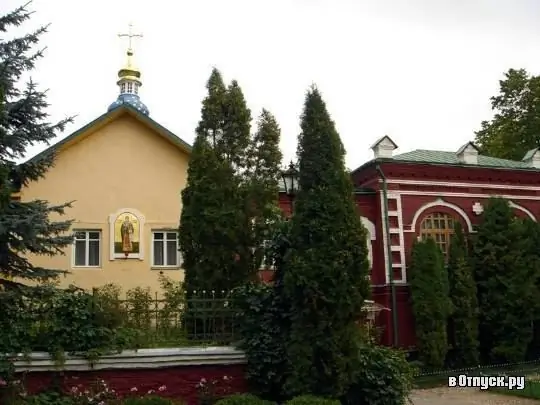
Description of the attraction
One of the most famous monasteries in Russia is the Pskov-Pechersky Monastery, located seventy kilometers from the city of Pskov. The monastery was rebuilt in a deep ravine where the Kamenets stream flows. From afar, the buildings of the monastery are almost invisible. Hidden behind the stone walls of the fortress, behind the high slopes of the banks, the monastery suddenly reveals itself in all its glory to the admiring spectator. On the territory of this monastery is the Lazarevskaya church, named so in memory of the gospel righteous Lazarus of the four days, resurrected by Jesus Christ, after spending four days in his grave.
The modest and unassuming Lazarevsky temple was built over a long period, its construction took eight years. It was built between 1792 and 1800. The church and the adjacent building were built under Archimandrite Peter (Mozhaisk). The building of the Lazarus the Righteous Church - built of stone, has two floors, one-domed with a glazed veranda - is located in the northeastern part of the monastery, opposite the Cathedral of the Assumption of the Virgin. The church is installed on a basement. The basement rooms have exactly the same size, they are covered with corrugated vaults defined on the supporting arches installed in the center. The plan of the lower floor exactly coincides with the plan of the basements, except for a small tent, which is covered with a corrugated vault at the end of the northern wall.
The temple is located on the lower square of the monastery next to the "bloody path" (the name of the descent from the church of St. Nicholas to the lower square). The facade of the building from the north-east side has an exit to the utility yard and from here it goes into a two-part basement. The entrance to the temple itself is from the main facade, which has an exit to the lower square, or through two side-altars, standing side by side. The only decoration of the church is the Baroque chapter, which is crowned with a faceted drum with a pedestal. The porch, which faces the main façade, has a simple gable. The temple walls are lined mainly with slabs and only partially with bricks. They are plastered and pink in color. The foundation of the church is rubble, the floor is lined with slabs and boards. The part of the chapter at the bottom is blue with appliqués with gilded stars; the upper part of the chapter is also gilded. The dimensions of the temple are not very large: it is twenty-two meters long and twelve meters wide.
Earlier, a monastery hospital was located at the church, later turned into the abbot's house, in view of the fact that the former abbot's house was destroyed by fire in 1848.
The church has an interesting fate. She helped to heal the souls of the sick, who were treated in the monastery hospital, there was a time when a small diocesan factory for the production of candles worked within the walls of the temple, and in 1849 the abbot of the monastery lived here. Since 1883, there was a hotel here, arranged for pilgrims-pilgrims. And in the 90s of the last century - the monastery archive and library. In 1967, the church underwent current repairs. Renovation work was carried out inside the church, painting of the church was also carried out.
In the church of Righteous Lazarus, the Unsleeping Psalter is read around the clock. Prayer is performed invisibly, but healing perceptibly strengthens, preserves those for whom the monks of God pray day and night. On kathisma, here every day, the commemoration of the living and deceased Orthodox Christians, who are included in the monastery synodikon, is repeatedly performed.






